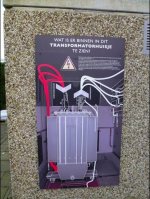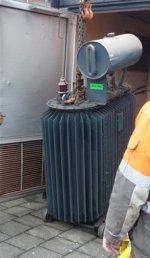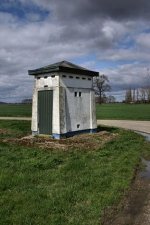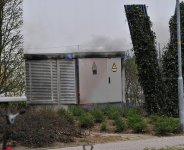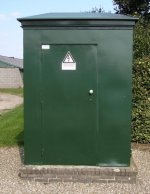Main reason for three phase power is motor torque is a constant, whereas with single phase motor torque is pulsating. The high vibration leads to low reliability, and in higher power applications the benefit of constant torque becomes a necessity. Conductor size reduction is a side benefit.
In Australia we have 200kVA distribution transformers on the pole dropping 66kV delta down to 240V star. (415V between phases) Houses get phase A, B or C but they are all out there in the street. I actually have 3-phase - cost an extra $200 when the house got built 18 years ago. No questions asked. Normal supply is 1 x 80 amps but this is 3 x 60 amps.
Last edited:
Overkill has no place with diy stuff.For a stereo (or even mono) amp? It seems overkill.
Even though 3 phase has been available for many decades over here to residential areas, its usage is limited. In most (older) houses the main fusebox can hold three fuses but is equipped with only one because the meter, fusebox and wiring are only for single phase. But with 230 V mains, 16 A fuses/circuit breakers allow for 3,680 W (per subcircuit) which is more than enough for ovens, washing machines and laundry dryers.
The aim is to get a balanced load on all three phases, so a third of the houses is connected to L1, a third to L2 and a third to L3.
Having said that, I do know that there are some houses with all three phases connected, esp. newer buildings where the electrical system was wired with the 3 phase system in mind. But domestic usage is very limited to high power devices like induction cookers and the odd hobby workshop with 3 phase equipment (like e.g. >165 A MIG welders) . But the wall sockets in living rooms,etc. are always single phase and my guess is >95% overall residential usage is single phase.
The aim is to get a balanced load on all three phases, so a third of the houses is connected to L1, a third to L2 and a third to L3.
Having said that, I do know that there are some houses with all three phases connected, esp. newer buildings where the electrical system was wired with the 3 phase system in mind. But domestic usage is very limited to high power devices like induction cookers and the odd hobby workshop with 3 phase equipment (like e.g. >165 A MIG welders) . But the wall sockets in living rooms,etc. are always single phase and my guess is >95% overall residential usage is single phase.
Last edited:
hmm intresting, i did not know 3 phase is not available world-wide in homes, it is more than common here. I actualy managed in the mean time to speak with one of the employees of the electric serice company, and according to that person here single phase is highly uncommon 
what a surprise.
And we have 60 hz main lines.
So the humm would be 360 hz or so.
My main reason for thinking about 3 phase was not the higher power available, but the chanse to get a smoother DC. But now that i know that 3 phase is uncommon in the majority of the homes world wide it is understandable that high fidelity stuff usualy uses only 1 phase.
what a surprise.
And we have 60 hz main lines.
So the humm would be 360 hz or so.
My main reason for thinking about 3 phase was not the higher power available, but the chanse to get a smoother DC. But now that i know that 3 phase is uncommon in the majority of the homes world wide it is understandable that high fidelity stuff usualy uses only 1 phase.
Wow, how this audio forum continues to degrade when power systems are discussed.
???
On the east coast, this is true. On the west coast, it seems they use two bushing transformers. From SanFran to Napa, all I saw was two bushing..This is the most cost effective way to provide single phase; yes, they could install a transformer suitable for line-line single phase primary, but the extra bushing adds to the cost. Secondary winding simply has a grounded center tap, 120/240V.
And we have 60 hz main lines.
So the humm would be 360 hz or so.
No. 60 hz 3 phase will produce 60 hz hum. What can change is the relative phase of the hum. Non linear devices can still produce harmonic content.
j
I have seen numerous posts claiming that North America does not use the 3phase system and that they have a split phase system.
Poppycock.
Look outside at the cables strewn across the country. They are in groups of three for the three phases. Just like everywhere else that uses a 3phase system.
The lines on the top of the wooden poles along the street run 3-phase 7.2KW to earth (~13KW phase to phase) but the typical residential house transformer primary is connected to only one phase. The secondary is center taped for the Edison split phase 120VAC - neutral - 120VAC. This way only one wire is required to be run to a rural home that is far from the distribution line. For a neighborhood with several houses, they will each be connected to different lines to balance the loading on the 3 phases. There are some line to line residential transformers but they are the minority, extra cost is a reasonable sounding reason.
I wonder if this has to do with seismic issues and grounding, or trying to keep more even loading on the lines.On the east coast, this is true. On the west coast, it seems they use two bushing transformers. From SanFran to Napa, all I saw was two bushing..
Last edited:
I do not know. I do know that the single bushing used on the east coast seems to present a stray current issue that two bushing systems do not have.I wonder if this has to do with seismic issues and grounding, or trying to keep more even loading on the lines.
I'd suspect grounding by itself...
j
On the east coast, this is true. On the west coast, it seems they use two bushing transformers. From SanFran to Napa, all I saw was two bushing..
You sure you're not looking at regulators or oil switches? They often have that same pole-mount design. Line-line is better from an engineering standpoint, but single bushing is no question the lowest cost (one less switching device, fuse, and arrester). For utilities cost will usually trump optimal design.
Significant application where I see two bushing single phase transformers:
1. Three xfmrs connected delta for a three phase system, where one can fail and the remaining two can be connected in open delta at reduced kVA.
2. Ungrounded or high impedance grounded three phase system, with no neutral available.
Perhaps you can provide pics, because I still have doubts about your claim. We are talking residences here...
Conventional Transformer
Typical picture of a single phase transformer for residential service. The bushing is the ribbed insulator sticking out of the top cover. There is a conductor through the center which carries the current to the hot end of the primary winding. A bushing is designed to bring an energized conductor through a tank wall, insulating the conductor from the tank wall.
Typical picture of a single phase transformer for residential service. The bushing is the ribbed insulator sticking out of the top cover. There is a conductor through the center which carries the current to the hot end of the primary winding. A bushing is designed to bring an energized conductor through a tank wall, insulating the conductor from the tank wall.
Since our country is essentially sitting on sand and not rock, almost all wiring except very high voltage distribution lines is underground, so we don't have transformers sitting on poles. What we do have are little houses in quarters that hold somewhat bigger transformers. High energy consuming plants will have their own transformers on the premises.
Attachments
Sand and rock and clay and loess and any other ground conditions have little to nothing to do with the choice the electricity transmission company make when locating their cables.
It is quite simply cheaper to hang the transmission lines from poles/towers than to bury them.
A pole mounted transformer can be supported by almost any ground condition. There are exceptions, as you may expect. peat/ quicksand (water flowing up through sand)/bog/marsh etc would be quite difficult terrain for any cable laying/stringing operation.
It is quite simply cheaper to hang the transmission lines from poles/towers than to bury them.
A pole mounted transformer can be supported by almost any ground condition. There are exceptions, as you may expect. peat/ quicksand (water flowing up through sand)/bog/marsh etc would be quite difficult terrain for any cable laying/stringing operation.
US underground residential service is also quite common. It was not discussed earlier, because the point being made was that most of these transformers are single bushing single phase. The average Joe cannot drive around and see this to be the fact with underground service, so I brought up overhead.
But the same condition applies. We use small pad mount dead fronted units with a single bushing for the energized end of the primary. It is common the neutral end of the winding is not even brought out of the tank, but is internally grounded to the tank. Makes for difficulty in testing these units. There is then a grounding pad provided on the tank. Lowest cost solution with minimal components.
The primary cable is special, called URD (Underground Residential Distribution). It is a concentric neutral cable: Underground Copper 15kv
The neutral can be either fully rated (equal to the ampacity of the inner conductor) or 1/3 rated for networks in 3 phase systems. In our neck of the woods, aluminum conductor is still in high use, due to cost (again). The purpose in using this type of cable is it provides both phase conductor and return in the same jacketed single cable. Easy install, low material cost, error-free connection. Cable is rated for direct burial.
Cheap cheap cheap, but quite reliable. The utility stocks these cables in copious amounts, and standardizes on transformer sizes, so only has to stock a few types of spares. Something pops, no problem, swap it out and move on.
Regarding grounding, Andrew is correct, the composition of the earth has little effect on what the utility does. The utility system uses the earth as a constant multipoint reference, not as a conductor. A neutral is carried through in all the systems I have discussed, and is grounded with rods at regular intervals, as well as at the transformer. So while there is the potential for ground currents to flow, and they do, it is in relatively small amounts. The earth is a good conductor only because there is so much of it, not because it has low resistivity; it does not when compared to copper and aluminum. Broken neutrals will cause regulation issues, but the multipoint grounding method minimizes the effect to a degree.
The IEEE Red and Green books have documented equations that describe quantitatively how a system is grounded. It can be effectively grounded or high impedance grounded, and is related to the ratio between positive and zero sequence impedances. In general, grounded systems are preferred, with more antiquated high impedance systems being obsoleted. The older system in my area was 26.4 kV distribution for commercial use. It was grounded wye back at the substation, but the neutral was never carried through. By the time you were a few miles away, this grounded system was effectively a high impedance grounded system due to the earth as the only return conductor. In the few cases where single phase was needed from this system, a two bushing unit was required. This system is almost completely phased out now for a 24.9 kV grounded system, with neutral carried. Now the utility can use one system and serve both 3 and single phase circuits more cost effectively. Regulation is also simpler and cheaper with a neutral available. Ground fault protection/relaying is simpler and more effective when you have a low impedance return path.
But the same condition applies. We use small pad mount dead fronted units with a single bushing for the energized end of the primary. It is common the neutral end of the winding is not even brought out of the tank, but is internally grounded to the tank. Makes for difficulty in testing these units. There is then a grounding pad provided on the tank. Lowest cost solution with minimal components.
The primary cable is special, called URD (Underground Residential Distribution). It is a concentric neutral cable: Underground Copper 15kv
The neutral can be either fully rated (equal to the ampacity of the inner conductor) or 1/3 rated for networks in 3 phase systems. In our neck of the woods, aluminum conductor is still in high use, due to cost (again). The purpose in using this type of cable is it provides both phase conductor and return in the same jacketed single cable. Easy install, low material cost, error-free connection. Cable is rated for direct burial.
Cheap cheap cheap, but quite reliable. The utility stocks these cables in copious amounts, and standardizes on transformer sizes, so only has to stock a few types of spares. Something pops, no problem, swap it out and move on.
Regarding grounding, Andrew is correct, the composition of the earth has little effect on what the utility does. The utility system uses the earth as a constant multipoint reference, not as a conductor. A neutral is carried through in all the systems I have discussed, and is grounded with rods at regular intervals, as well as at the transformer. So while there is the potential for ground currents to flow, and they do, it is in relatively small amounts. The earth is a good conductor only because there is so much of it, not because it has low resistivity; it does not when compared to copper and aluminum. Broken neutrals will cause regulation issues, but the multipoint grounding method minimizes the effect to a degree.
The IEEE Red and Green books have documented equations that describe quantitatively how a system is grounded. It can be effectively grounded or high impedance grounded, and is related to the ratio between positive and zero sequence impedances. In general, grounded systems are preferred, with more antiquated high impedance systems being obsoleted. The older system in my area was 26.4 kV distribution for commercial use. It was grounded wye back at the substation, but the neutral was never carried through. By the time you were a few miles away, this grounded system was effectively a high impedance grounded system due to the earth as the only return conductor. In the few cases where single phase was needed from this system, a two bushing unit was required. This system is almost completely phased out now for a 24.9 kV grounded system, with neutral carried. Now the utility can use one system and serve both 3 and single phase circuits more cost effectively. Regulation is also simpler and cheaper with a neutral available. Ground fault protection/relaying is simpler and more effective when you have a low impedance return path.
What we do have are little houses in quarters that hold somewhat bigger transformers. High energy consuming plants will have their own transformers on the premises.
Love the cute little conservator (oil expansion tank). US only sees those guys on the big substation and GSU xfmrs. Do these houses only hold one or multiple units? The use of network systems is common in urban areas, held in vaults under the sidewalk, but not really for suburban or rural areas. Seems like if you're going to build a house, might as well put a bunch of equipment inside, not just one transformer.
Sand and rock and clay and loess and any other ground conditions have little to nothing to do with the choice the electricity transmission company make when locating their cables.
Here it's probably been the government's decision to put everything but power lines of 50 kV and higher (predominantly 150 kV and 380 kV) underground. That includes remote areas (not that "remote" really exists in this densely populated country). AFAIK, it has been like that since before I was born when utility companies were still run by the government.
I mentioned the sand as it makes putting things underground relatively easy.
It is quite simply cheaper to hang the transmission lines from poles/towers than to bury them.
Yes it is. It looks messy, though. There's another advantage now that copper is expensive, it's hard to steal. Overhead wires from the railways getting stolen is not unheard of anymore.
Love the cute little conservator (oil expansion tank). US only sees those guys on the big substation and GSU xfmrs. Do these houses only hold one or multiple units? The use of network systems is common in urban areas, held in vaults under the sidewalk, but not really for suburban or rural areas. Seems like if you're going to build a house, might as well put a bunch of equipment inside, not just one transformer.
Litterally translated we would call them "tranfsformer houses" but ofthen they're just concrete blocks. They come in all shapes and sizes. So I guess some hold one, others more.
Some are located close to a house, others are in the middle of the street. They used to be built from masonry, nowadays they're often hideous concrete blocks but sometimes there's someone with a creative solution for that.
The conservator is probably only found on older transformers of this size.
First pic is of an older one in a city, this is big enough to hold a few. The second one is in a rural area (not entirely sure, I don't see the high voltage flash symbol on the door). The last two pics are about as small as they get. I included the one with the fireman for scale. Something similar is on the premises of the company I work for (reflow ovens and solder machines use a bit of electricity).
Edit: the last pic show one of the smallest ones you can often find in the countryside near a farm, usually they're made from metal.
Attachments
Last edited:
- Status
- This old topic is closed. If you want to reopen this topic, contact a moderator using the "Report Post" button.
- Home
- Amplifiers
- Power Supplies
- why not 3 phase?
